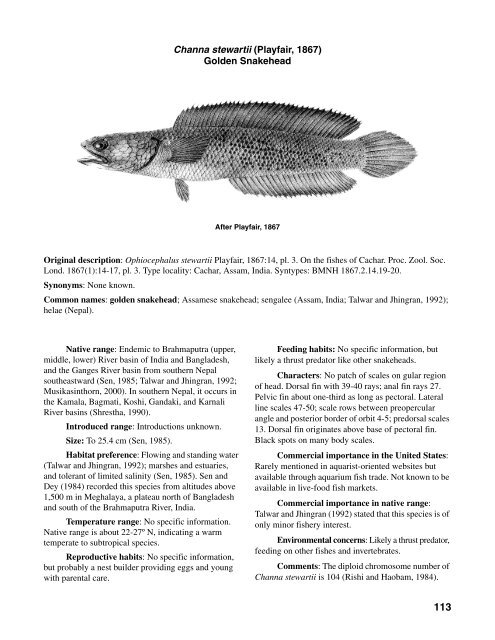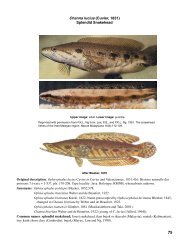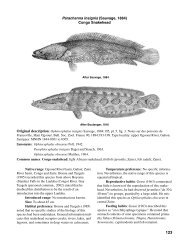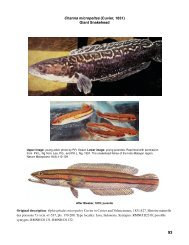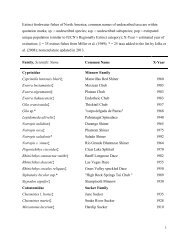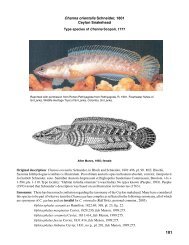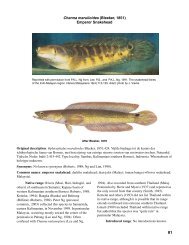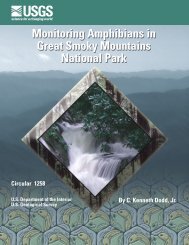Channa pleurophthalma (Bleeker, 1851) Ocellated Snakehead
Channa pleurophthalma (Bleeker, 1851) Ocellated Snakehead
Channa pleurophthalma (Bleeker, 1851) Ocellated Snakehead
- No tags were found...
Create successful ePaper yourself
Turn your PDF publications into a flip-book with our unique Google optimized e-Paper software.
<strong>Channa</strong> stewartii (Playfair, 1867)Golden <strong>Snakehead</strong>After Playfair, 1867Original description: Ophiocephalus stewartii Playfair, 1867:14, pl. 3. On the fishes of Cachar. Proc. Zool. Soc.Lond. 1867(1):14-17, pl. 3. Type locality: Cachar, Assam, India. Syntypes: BMNH 1867.2.14.19-20.Synonyms: None known.Common names: golden snakehead; Assamese snakehead; sengalee (Assam, India; Talwar and Jhingran, 1992);helae (Nepal).Native range: Endemic to Brahmaputra (upper,middle, lower) River basin of India and Bangladesh,and the Ganges River basin from southern Nepalsoutheastward (Sen, 1985; Talwar and Jhingran, 1992;Musikasinthorn, 2000). In southern Nepal, it occurs inthe Kamala, Bagmati, Koshi, Gandaki, and KarnaliRiver basins (Shrestha, 1990).Introduced range: Introductions unknown.Size: To 25.4 cm (Sen, 1985).Habitat preference: Flowing and standing water(Talwar and Jhingran, 1992); marshes and estuaries,and tolerant of limited salinity (Sen, 1985). Sen andDey (1984) recorded this species from altitudes above1,500 m in Meghalaya, a plateau north of Bangladeshand south of the Brahmaputra River, India.Temperature range: No specific information.Native range is about 22-27º N, indicating a warmtemperate to subtropical species.Reproductive habits: No specific information,but probably a nest builder providing eggs and youngwith parental care.Feeding habits: No specific information, butlikely a thrust predator like other snakeheads.Characters: No patch of scales on gular regionof head. Dorsal fin with 39-40 rays; anal fin rays 27.Pelvic fin about one-third as long as pectoral. Lateralline scales 47-50; scale rows between preopercularangle and posterior border of orbit 4-5; predorsal scales13. Dorsal fin originates above base of pectoral fin.Black spots on many body scales.Commercial importance in the United States:Rarely mentioned in aquarist-oriented websites butavailable through aquarium fish trade. Not known to beavailable in live-food fish markets.Commercial importance in native range:Talwar and Jhingran (1992) stated that this species is ofonly minor fishery interest.Environmental concerns: Likely a thrust predator,feeding on other fishes and invertebrates.Comments: The diploid chromosome number of<strong>Channa</strong> stewartii is 104 (Rishi and Haobam, 1984).113


